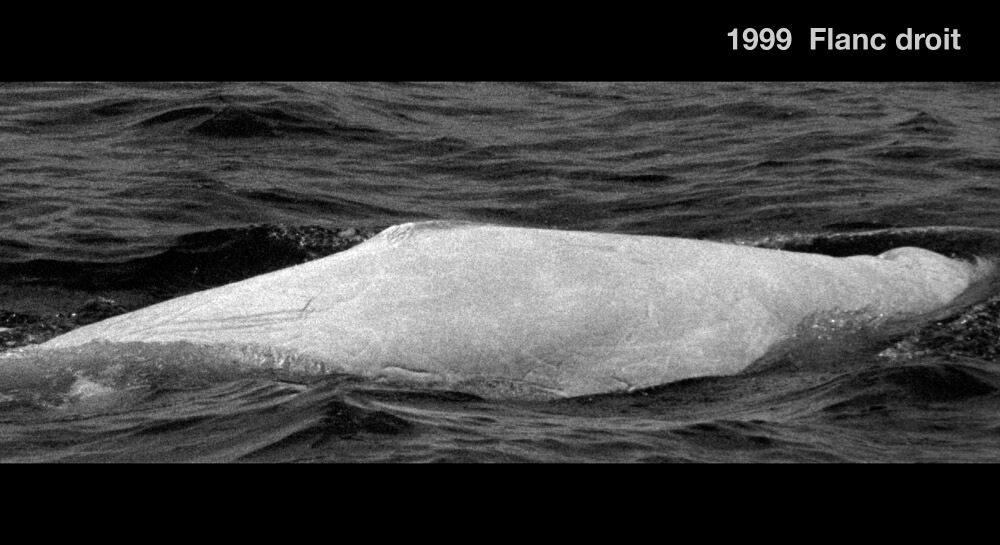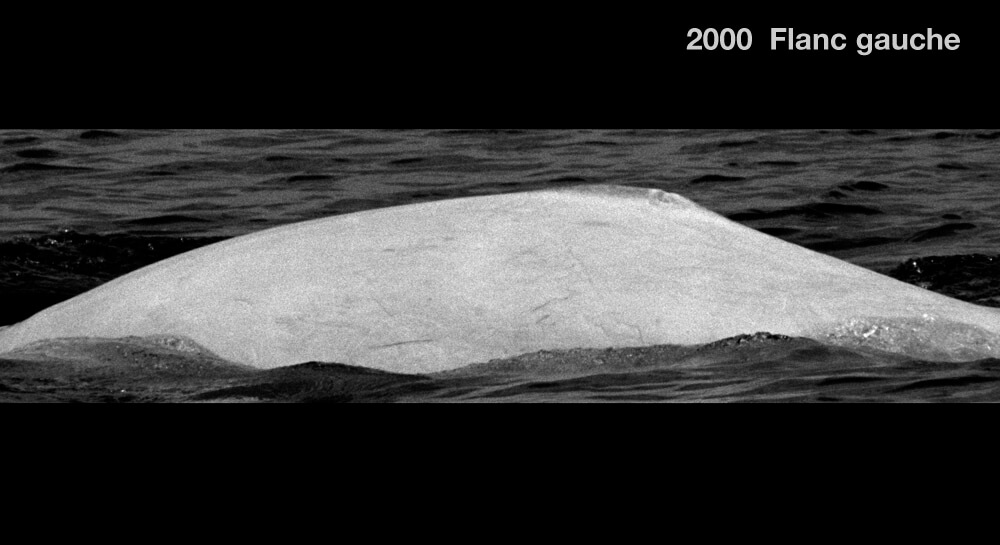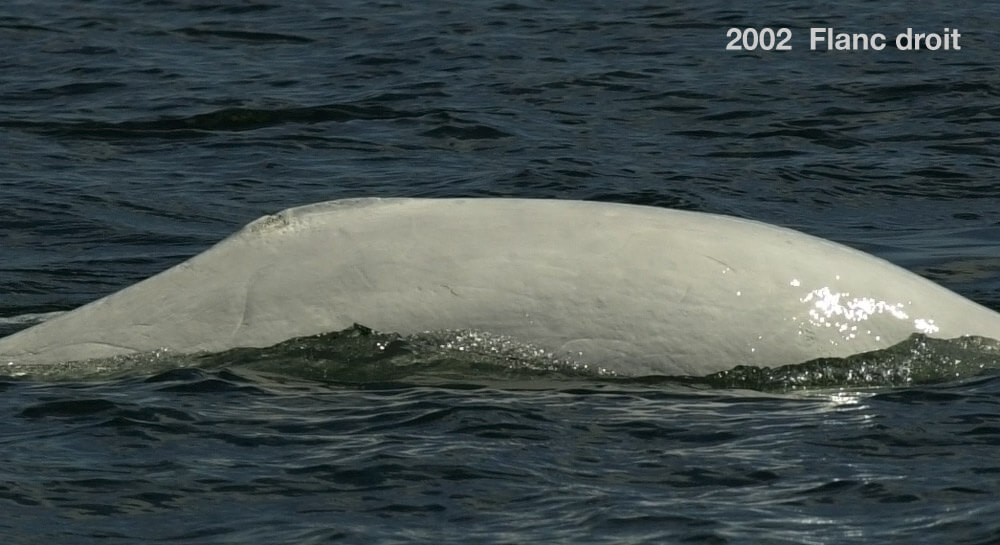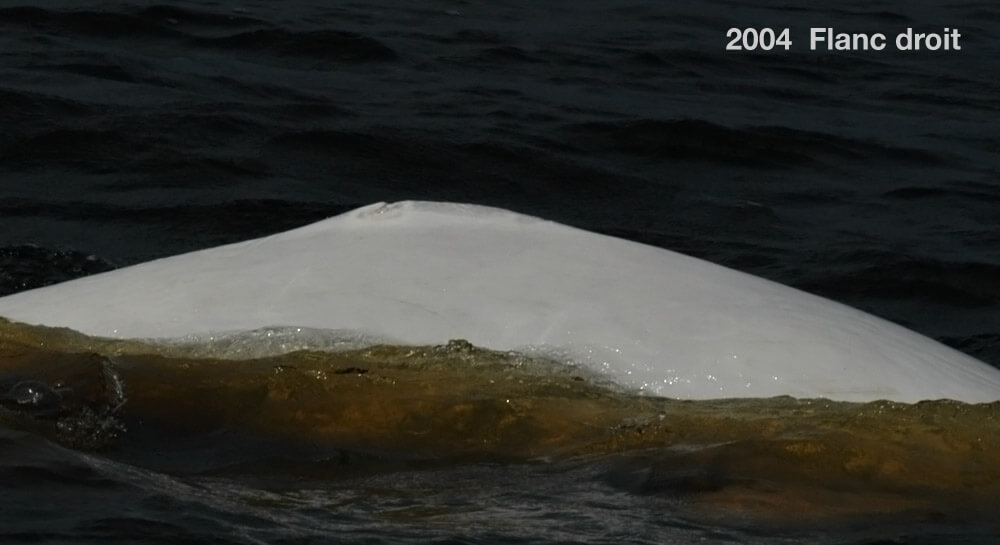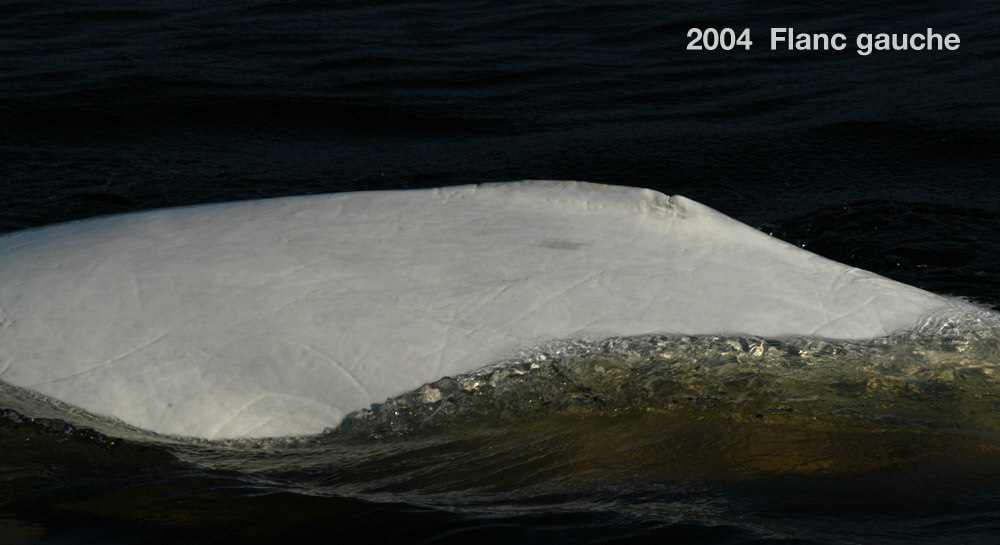Polynix
Beluga

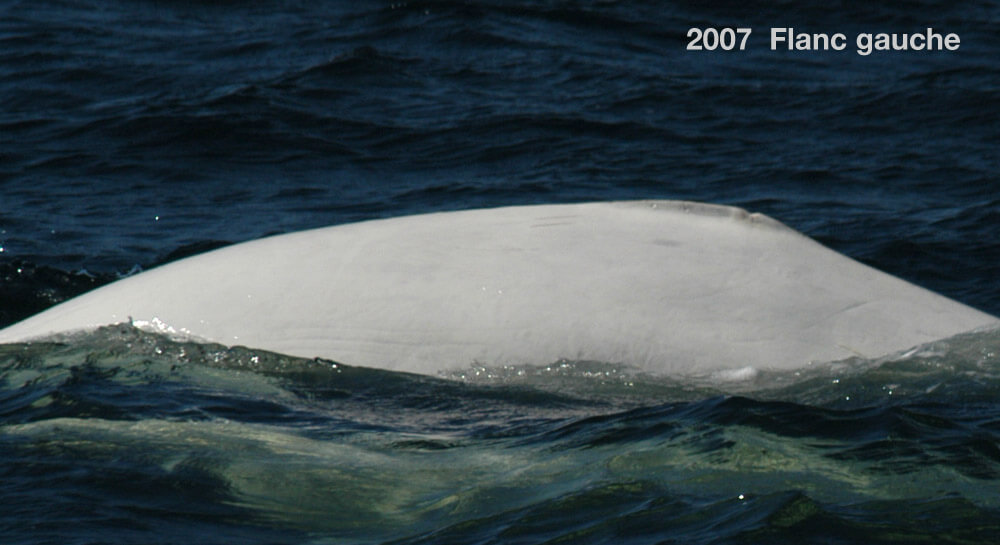
Adopted by collective sponsors
-
ID number
DL1328
-
Sex
Male
-
Year of birth
Around 1990
-
Known Since
1997
Distinctive traits
Polynix stands out in part thanks to the uniquely-shaped scar located in the hind part of the dorsal crest. It also has a small gray spot on its right flank, below the crest.
Life history
We first encountered Polynix in 1997. He was still gray at the time, but already of considerable size. He turned white in the mid-2000s, which leads us to believe that he was born around 1990. Indeed, belugas fade from gray to white in colour between the ages of 12 and 16.
Having only his associations and the sectors he frequented to go by, we were unable to determine Polynix’s sex with certainty. In 2004, we placed a tag on Polynix’s back in order to track his diving behaviour over the course of several hours. When we recovered the tag, a tiny bit of skin remained stuck to the suction cup. After genetic analysis, we were able to confirm that Polynix is a male.
In 2017, while analyzing photos of DL1587, we realized that it was actually DL1328! This beluga had appeared under two different names in the catalogue. Now we can add new chapters to Polynix’s profile, which will shed light on how his life is unfolding.
DL1328 was named Polynix on July 27, 2018. The group sponsors were able to vote to name their beluga whales when the $5,000 was raised. The name Polynix was proposed by students at Polyno High School in La Sarre, Abitibi-Témiscamingue.
The stories of young belugas and the chance to monitor the evolution of their behaviour are our best tools for understanding the social lives of this species. By better understanding how belugas live, we will be able to better protect them.
Observations history in the Estuary
Years in which the animal was not observed Years in which the animal was observed
Latest news
Rain or shine, here we go! With the season a little shortened by the COVID-19 situation, we can’t afford to miss a day on the water. Aboard the BpJAM, our research inflatable, we head for Ile aux Lièvres, off Saint-Siméon. We meet our first herd of around 15 belugas. After a few shots, we abandon them, as the light doesn’t give us good enough shots to identify the belugas. We join a second herd, this time of 25 to 30 belugas. Here, the light is better. In this herd swim adults, juveniles and a calf (the one in the photo with Polynix – is it his little brother or sister?). The belugas seem to use the current bar to feed. The belugas dive and come up quickly, which we call “miling”. After an hour of trying to photograph the left and right flanks of each beluga, we move on to the south side of the island. Another group of belugas are busy heading for the Pot-à-l’Eau-de-Vie islands. Polynix is swimming actively in this herd of 50 to 60 belugas. They too are diving and taking advantage of the current bars. This area is definitely attracting white whales today!
On board the Bleuvet, we observe a large herd of belugas in the morning. The majority of individuals are maintaining the same course, but one small group is very dynamic and seems to be darting at full speed in every which direction. They look like torpedoes!, even if they occasionally slap their tails on the surface. Indeed, all of this activity is intriguing, but today we’re looking to place a data archiver on the back of a beluga. So we try to find a more mild-mannered group. Continuing toward Rivière-du-Loup, we observe a herd of some fifty belugas. Among them, we identify Polynix. A grey beluga approaches the boat and Michel Moisan manages to place the tag on its back. For nearly 5 hours, the tag was able to record the beluga’s movements and vocalizations! Will we hear Polynix’s voice in the audio recordings? It’s possible, but that doesn’t mean it will be easy to recognize!
The air is laden with moisture. We are on board the Bleuvet, in the sector around the mouth of the Saguenay. Some 80 belugas are swimming around us, including adults and a few young. The herd splits into 8 or 9 groups of about ten animals each. Amongst them, we recognize DL1328. The animals are swimming dynamically, and we can even hear them grunting, whistling and breathing loudly. They are moving very fast! We’ve been watching this herd for an hour. The belugas begin to dive for longer periods, which makes them difficult to follow. We decide to go search for another herd.
We were out that day with a project to place satellite tags on belugas as part of the Sur la trace des bélugas project. Aboard Le Bleuvet, we found ourselves near Ile aux Basques, off the coast of Trois-Pistoles. A herd of 70 individuals, mostly adults with a few calves, is close by. From the size of the individuals and their behavior, we think we’re close to a herd of males.
Among the belugas, we note the presence of DL1328. He’s swimming with a youngster. The herd is divided into three groups scattered over a distance of almost a kilometer. On a few occasions, we can hear the vocalizations of certain belugas.
Despite the rain, we try to place a beacon on a beluga’s back, but without success. Given the poor weather conditions, we postpone the project until a later date.
Sponsors
Students from Polyno high school
130 students from Polyno high school in La Sarre, Abitibi-Témiscamingue, worked together to raise $1876 to adopt beluga whale DL1328. They came up with the name Polynix, a fine blend of the name of their school and that of their sports team Phénix. Read about their project in L’Écho Abitibien.
Iris Dion
In honor of Eléa Dion. For the birthday of my sister, who was born the same year as this beluga and loves deep water almost as much. I suggest we call her Lalo.
Anne-Marie Pichette
Thank you for allowing me to help you a little in your mission! I suggest Hope for his name. In homage to all those who speak out to protect our belugas.
Cathy Faucher Illustration
Following the socio-financing campaign to finance my project for a special “whale” animal alphabet book based on my illustrations, I’m pleased to honor my commitment to donate 10% of the amount raised in 30 days, or $320. Thank you for being there to preserve, educate and raise awareness of the issues facing these inhabitants of the St. Lawrence, who are linked to us and our environment. Thank you for letting us participate in their protection.
St-Edmund beluga keepers
We’re really excited about adopting a beluga.We’ve worked hard to raise the money and we’re happy with what we’ve accomplished. We’re proud to support research in the St. Lawrence River. Marine mammals are a treasure and we want to keep them! We propose the name Bubbles.
Louise Carrier
For Christmas, I offered to adopt a beluga whale for my grandchildren. We suggest christening it with the first letters of our first names: Lourobatclaan. For Louise-Romane-Bat-Clara-Anais.They’re absolutely delighted.
Charlene Daubenfeld
Thank you to all my wonderful friends who gave me the gift of helping to adopt a St. Lawrence beluga whale for my 30th birthday. And thank you to GREMM for your exceptional work! I propose to name this beluga Charlie :).
Karollanne Simard (5th donation)
In honor of Joe Howlett.
Claude Misercque-Piret
In memory of a wonderful visit to GREMM.
Simon Caron (6th donation)
Sandrine Leblanc
Thank you very much for this wonderful initiative, Karine Leblanc.
Martine Thibault
As DL1328 was born the same year as our daughter Andréanne, we’d like to name this beluga Bazou. It was the affectionate nickname given to our daughter.
Judith Allard
Thank you for your involvement in helping to protect these wonderful creatures! I hope my small donation will help. My suggested name is Tillikum. In honor of the orca in captivity at Orlando Seaworld and for all the marine animals in captivity there.
Marc-André Vincent
Without knowing her personally, I support Ms. Mélanie Deschênes. So that all future generations will know about belugas.
Sept-Îles elected officials
Audrey Hottin (23rd donation)
I propose the name Heurtel!
Mélanie Deschênes
On behalf of my children, so that their grandchildren will know about belugas.
Pierre Bouchez
In memory of my trip to Canada and the sunset reflected on the back of a beluga school, I propose Sunrise as the name for DL1328.
Guilhem Molinier
In honor of Ariane Deschênes. Many thanks for this beautiful Beluga!
Graphic design students, Université Laval
Following our university project, we became aware of the threats facing belugas.Now aware of the dangers, we want to contribute to scientific research so that solutions can be proposed. We propose the name Jérôme for this beluga, in honor of our professor who initiated this project!
Nolween Dinel (7th donation)
In memory of the belugas we were lucky enough to see on our fabulous trip to Gaspésie, we’d like to support your work. Suggested first name: Zélie if it’s a female and Splash if it’s a male.
Ginette Deschênes
In honor of my late father Ray and my brave mother Sol, if it’s a male RaySol and if it’s a female SolRay. Congratulations on this project and thank you for allowing us to get involved.
Annie Marineau
Monique Ouellet
Brigitte Hannequin
The Tousignant-Bouchard family wish a long life to the belugas and other organisms of our majestic river!
Marilou Fitzback
To my childhood lulled by their songs. Keep up the good work!
Étienne Aillot
In honor of Lola Couderc’s 27th birthday, France. Thank you for your involvement in saving marine mammals, keep it up 🙂 For the name of the Beluga I suggest: Lola if it’s a female, Etienne if it’s a male, Thank you very much, have a nice day.
Maria Smith
Sarro McElmurray and Guénole Conte Family
Continue to understand and save marine mammals. Suggested name: Bianco.
Jana
For Mia!
Karen
For Mia 13th birthday!
Beckey
This donation was made by Becky to celebrate the birthday of her friend Mia.
Adele
In honour of my friend Mia on her 13th birthday.
Maria
Our family loved going whale watching and visiting the marine mammal interpretation center in Tadoussac this summer. This donation is from our 12-year-old daughter Mia. Keep up the great work to protect the belugas!
Camille Campagna
Hello, I’m a student in water management and control, and I’m passionate about marine species, especially belugas! I’d like to congratulate you on your work to save this species. I wish you all the best! I suggest the name Thalassa for this lovely beluga!
Charline Provost
Lou Chilliet
Nicole and Pierre Guérini
Andréanne Bienvenue
Keep up the good work! From a biologist who loves these beautiful animals!
Geneviève Poirier
Isabelle Leduc
The UNESCO Youth Committee of the Montreal School Board’s Atelier School
The committee is made up of 8 young people, two of whom have already seen belugas in Tadoussac. This is the Year of Water at their school, so they’re keen to get involved in our cause. Suggested name: Atelier, in honor of their school.
Rafaelle Prud’homme
Yvonne Richard
Zoé and Théa and their parents Myriam Ocio and Pascal Briand

